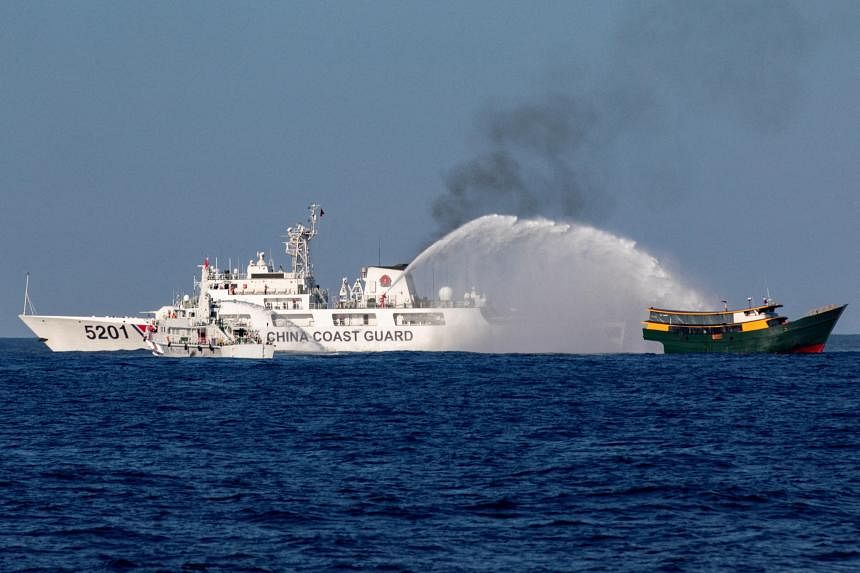WASHINGTON – China’s status as South-east Asia’s preferred superpower in a new ISEAS – Yusof Ishak Institute survey is likely to be short-lived, say analysts.
The annual survey of 1,994 policymakers, journalists, businessmen and analysts in Asean nations showed that they would prefer China over the US – if forced to align with either strategic rival – by a narrow margin of 50.5 per cent to 49.5 per cent.
The findings, published in the institute’s The State Of South-east Asia 2024 report on April 2, point to a reversal of trends seen in the last four surveys. In 2023, 61.1 per cent chose the US, while 38.9 per cent went with China.
Analysts told The Straits Times that the findings are not too surprising and do not necessarily mean the region is uncritically closer to China.
The survey is consistent with trends seen in data from other sources over recent years, said Mr Gregory Poling, who directs the South-east Asia Programme and Asia Maritime Transparency Initiative at the Washington-based Centre for Strategic and International Studies.
“That said, I’m not prepared to say those trends are towards a long-term preference for China,” he said, noting that the Gaza war – identified as the region’s top geopolitical concern – had impacted responses captured in the survey.
The downward trend in trust for the US appears concentrated among the three Muslim-majority countries of the region, which suggests it is tied to the war in Gaza, he said.
Since Malaysian and Bruneian elites were already more pro-China, the real shift here is the big swing in Indonesia, he pointed out.
“It’s too soon to say whether the shift in Indonesian opinion is long-term, like we saw under the Bush administration, or a short-term signal of frustration,” he added.
During the George W. Bush years, Indonesia had opposed the US invasion of Iraq after the Sept 11, 2001, terrorist attacks. It was also concerned that the war on terror fed Islamic xenophobia.
Mr Poling noted that other questions in the survey, like those related to the South China Sea, reveal greater distrust of China among Indonesian elites – as do other recent surveys, such as from the Foreign Policy Community of Indonesia.
“So there is reason to think these numbers could revert to a modestly pro-US tilt,” he said.
The survey’s methodology is also worth poring over, analysts said.
It is a survey of elites, and a tiny fraction of elites, in the cases of Indonesia, the Philippines, Vietnam, Thailand and Myanmar, Mr Poling said.
“It still has value as a data point, but should not be treated as a definitive reflection of elite opinion in the larger countries of the region,” he said.
In addition, he pointed out that ISEAS had designed the survey as a proxy for Asean as an institution, not South-east Asia as a region.
To do this, the survey weighed each country’s responses equally – each country’s responses were averaged and then counted as 10 per cent of the total. That skewed the overall averages in favour of the smallest countries, which lean more towards China.
“So by all means, we should note that the opinions of those elites who respond to ISEAS’ survey have shifted, but we can’t infer from that about where public or overall elite opinion in most of the region stands,” he said.
Likewise, Mr Blake Berger, associate director at the Asia Society Policy Institute in New York, said he would not read too much into the close 50-50 split in preference.
“It shouldn’t exactly be a surprise that the US took a hit in terms of confidence, especially as respondents relayed that the Israel-Gaza conflict topped South-east Asia’s list of geopolitical concerns,” he said.
The swing in opinion in Malaysia, Indonesia and Brunei, where more than 70 per cent of respondents said they would align with China, might appear concerning from a US foreign policy perspective, he said.
But this finding needs to be juxtaposed against answers to the question about whom the region trusted, he said.
Pointedly, China was seen as the fourth-most trusted partner, garnering 24.8 per cent support, while the US received 42.4 per cent of the vote, coming behind Japan, the country named as the region’s most trusted partner.
Mr Berger ascribed the shift away from the US to its failure to capture the public imagination in the trade-driven region.
“The US’ lack of a comprehensive strategy to economically engage South-east Asia has provided China avenues to make significant inroads in terms of regional influence,” he said.
Over the past decade, Asean’s trade in goods with China more than doubled, reaching US$722 billion (S$974 billion) in 2022 and accounting for nearly one-fifth of the grouping’s global trade.
Since 2020, Asean and China have been each other’s largest trading partners, amid the signing of notable agreements like the Asean-China Free Trade Agreement and the Regional Comprehensive Economic Partnership.
In comparison, the US was Asean’s second-largest trading partner, with goods and services trade with it amounting to an estimated US$520 billion in 2022 after almost doubling over a decade.
But despite having a smaller trading volume with the region, the US is still a vital export market for Asean goods. In 2021, Asean’s goods trade surplus with the US was US$145.9 billion, compared with its goods trade deficit with China of US$107.7 billion that same year.
The Indo-Pacific Economic Framework (IPEF), the Biden administration’s main vehicle for engaging the region, has failed to shore up regional confidence in the US’ economic engagement strategy, Mr Berger said.
The region remains sceptical that the two-year-old framework, which does not provide access to US markets, will deliver meaningful returns. Instead, the region fears that the IPEF will also raise compliance and adjustment costs of trading with the US.
Even as it considers options to diversify away from greater dependence on China, the region’s expectations of a more robust economic engagement with the US are unlikely to be met. Free trade is an unpopular topic with both Republicans and Democrats, especially in an election year.
Where the US could score higher was on the strategic side, said Mr Berger.
The survey surfaces increasing turbulence and “aggressive behaviour” in the South China Sea as the region’s second top geopolitical concern, he noted.
“This poll number, taken alongside the lack of trust in China, underscores that there’s far more nuance in the region’s outlook on both the US and China than the response to the ‘who would you align with’ question would have readers believe,” he said.
Thus, an interpretation of the 2024 poll as an indication that the region is turning to China or that this is part of a larger trend line in the region cannot be sustained, he said.
“The see-saw nature of the region’s stance on China only underscores this point,” he added.
The survey has also raised a question about Asean’s efficacy.
One implication of a more dominant China is the further diminishment of Asean as an organisation protecting and enhancing the sovereignty of regional states, Mr Berger said.
“Should China’s growing influence in South-east Asia coincide with an even more aggressive approach to the South China Sea and the further sidelining of Asean, that’s a situation that doesn’t bode well for any regional actor,” he said.
The ripples from the survey have also reached the Biden administration.
A State Department spokesman, while acknowledging the survey, reiterated that the United States was committed to delivering for the Indo-Pacific, with its vision for an open, connected, prosperous and secure region.
“In collaborating with our allies and partners in the region, we are not imposing a solution, but listening intently to their priorities and addressing their concerns,” the spokesman said.


